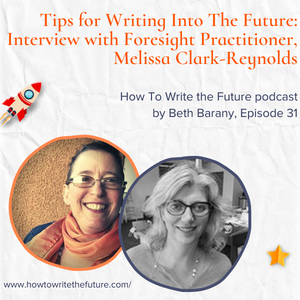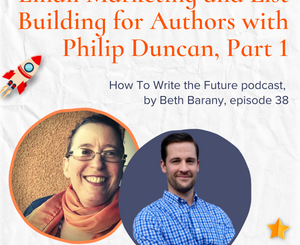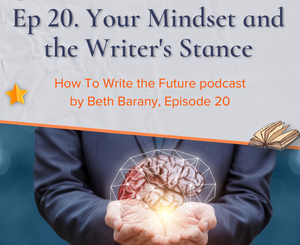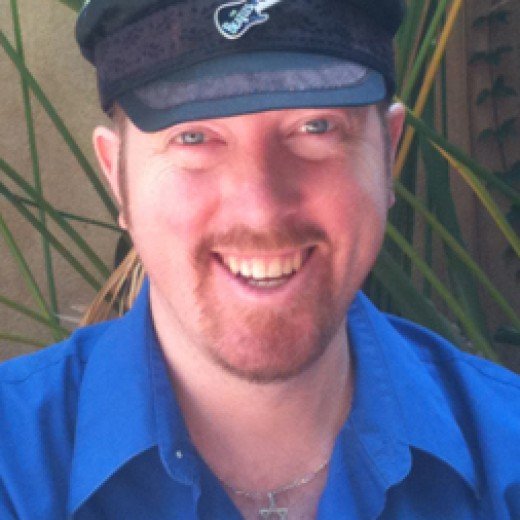Tips for Writing Into The Future: Interview with Foresight Practitioner, Melissa Clark-Reynolds
I’m fascinated by how futurists and foresight practitioners think about the future.
It is very different than how novelists usually think about their stories set in the future or in an alternative time.
Usually, we are thinking of only one kind of story in one kind of direction.
Whereas futurists and foresight practitioners think about multiple opportunities that might present themselves going forward.
And I find this mental exercise really eye-opening and useful as a science fiction writer.
Feeding my imagination.
Maybe this way of thinking will inspire you too.
Awesome.
Then check out the latest episode of How To Write The Future: “Tips for Writing Into The Future: Interview with Foresight Practitioner, Melissa Clark-Reynolds.
I’m kicking off a mini-series featuring futurist and foresight practitioner, Melissa Clark-Reynolds, and my friend.
Together we discuss how to solve future problems, including the importance of creating a vision from different possible futures, and what is backcasting.
Platforms the podcast is available on include Apple Podcasts | Google Podcasts | Spotify | Buzzsprout | Amazon Music | Podcast Addict| Youtube
RESOURCES
How To Write the Future:
http://howtowritethefuture.com/
Free World Building Workbook for Fiction Writers:
https://writersfunzone.com/blog/world-building-resources/
School of International Futures
Institute for the Future
Interview with Cat Tully, School of International Futures Founder (Episode 15, How To Write the Future podcast)
SHOW NOTES
“It is very different than how novelists usually think about their stories set in the future or in an alternative time. Usually, we are thinking of only one kind of story in one kind of direction. Whereas futurists and foresight practitioners think about multiple opportunities that might present themselves going forward. And I find this mental exercise really eye-opening as a science fiction writer.”
In this episode, “Tips for Writing Into The Future: Interview with Foresight Practitioner, Melissa Clark-Reynolds,” host Beth Barany, creativity coach, and science fiction and fantasy novelist, kicks off an exciting podcast mini-series featuring futurist and foresight practitioner, Melissa Clark-Reynolds as they discuss how to solve future problems, including the importance of creating a vision from creating different futures and what is backcasting.
Content Warning – briefly mentions abortion
About Mellissa Clark-Reynolds
Melissa Clark Reynolds ONZM, ChMInstD became a Foresight Practitioner and Professional Director after 30 years experience as a technology entrepreneur and CEO of a number of Technology companies. She sits on the Boards of Atkins Ranch, Alpine Energy Network, Daffodil Enterprises Ltd, and the NZ Future Bees Trust. Melissa was previously Chair of Little Yellow Bird, Deputy Chair of Radio NZ, the first independent Director of Beef & Lamb NZ, and a Member of MPI’s Primary Growth Partnership Investment Advisory Panel. Melissa has been part of the Te Hono Primary Sector Bootcamp at Stanford University, twice. She trained as a Foresight Practitioner with The Institute for the Future in Palo Alto and also with Clayton Christiansen in his approach to Disruptive Innovation through Harvard. She has also trained with Futurist Sohail Inayutollah in his approach to corporate narrative and content level analysis.
Melissa works with companies like AsureQuality, Kotahi, Lincoln University, the NZ Screen Sector, and BiosecurityNZ on Strategy and Foresight. Melissa has a particular interest in Platform and Subscription Business Models. She developed and teaches courses in Strategy, Digital Governance, and Disruptive Business Models for the NZ Institute of Directors.
ABOUT THE HOW TO WRITE THE FUTURE PODCAST
The How To Write The Future podcast is for science fiction and fantasy writers who want to write positive futures and successfully bring those stories out into the marketplace. Hosted by Beth Barany, science fiction novelist and creativity coach for writers.
Tips for fiction writers!
This podcast is for you if you have questions like:
- How do I create a believable world for my science fiction story?
- How do figure what’s not working if my story feels flat?
- How do I make my story more interesting and alive?
This podcast is for readers too if you’re at all curious about the future of humanity.
TRANSCRIPT FOR Tips for Writing Into The Future: Interview with Foresight Practitioner, Melissa Clark-Reynolds
Are you looking for a way to dig into your world, building for your story? Then I recommend that you check out my World Building Workbook for Fiction Writers. Now available. It’s at HowToWriteThe Future.com. Just head on over there. Click, sign up. Put your name and email, and there you go. That workbook will be delivered to your inbox straightaway.
Hey everyone, Beth. Barany here with How To write the Future podcast.
What is How To Write the Future podcast
This is a podcast that offers tips and support for science fiction and fantasy writers, and actually writers of all kinds who want to create positive, optimistic futures.
Because I believe when we vision what is possible and we put that into our fiction, we actually help make it happen in the world because our readers read them, feel it, and it can change their outlook.And when your outlook changes, you can change how you operate in the world, how you behave, and how you think.
I am a science fiction and fantasy author and writing coach and consultant. I work with individuals and organizations to help bring stories to life.
Intro for this podcast
Beth Barany
In previous episodes of how to write the future. I mostly shared my thoughts on various topics helping fiction writers to build their worlds and edit and market.
Now going forward, I will be doing interview episodes where I will be talking to futurists, foresight practitioners, subject matter experts, and other people who can help us as fiction writers build better stories.
This is the first of those interviews.
I’m very excited today to introduce you to a friend and a futurist and foresight practitioner, Melissa Clark Reynolds.
Melissa and I met this past summer at the School of International Futures.
And we have been having ongoing conversations over Zoom and Twitter and email.
In today’s episode, I’m going to have Melissa introduce herself to you. And we’re going to talk a little bit about what is it like to build scenarios as a futurist, as a foresight practitioner.
And one of the tools that they use to describe the past of the future.
I hope you enjoy this episode. Thank you so much for listening.
Do you wanna introduce yourself?
Melissa Clark Reynolds
Yeah. Hi. My name’s Melissa Clark Reynolds. I work as a futurist foresight practitioner. I particularly am interested in the future of food and agriculture and you can’t really do that without thinking about the climate. And I also have a particular interest in pandemics, human and animal.
So I studied a mixture of anthropology, epidemiology, and environmental planning.
I spent almost 30 years in software development, a whole lot of it in thinking about predictive analytics and how we might use software to analyzed both pandemics and water pollution and other kinds of pollution.
Strangely, fluid dynamics is very useful for thinking about epidemics.
So, yeah, so I have background in tech as well, kind of eclectic brain.
We met a futures course in the UK Yes, yes. But I live in New Zealand.
Beth Barany
And have you done this work in New Zealand primarily, or you’ve done it around the world?
Melissa Clark Reynolds
I’m mostly in New Zealand though I have done quite a bit of work, in Australia and in the UK.
Beth Barany
We, we met at a training the summer school for international Futures one-week intensive.
And something that I really took away from that is a lot of people who were there were very eclectic, had very eclectic backgrounds, and were already quite good at cross-thinking, you know, thinking across disciplines.
You’re not in software today, right? You don’t work in software now, but how, how did that work, like lend itself to your work in, in future foresight?
Melissa Clark-Reynolds
I’ve always been one of those entrepreneurs that was just a few steps ahead of the market, and sometimes that’s a virtue, and sometimes it’s a recipe for going broke.
It was of no great surprise to me that my orientation was to the future and I think I’ve always been like that as an entrepreneur, and software I’ve always been wanting to create things that didn’t exist and a lot of it has been to help to model the future.
Beth Barany
Perfect.
Melissa Clark-Reynolds
So, yeah, that kind of software just made sense.
I was late to this, the whole discipline of futurism or futurist thinking. I first trained with the Institute for the Future in Palo Alto in 2016, and I’ve been running a Futures Practice, Future Center New Zealand since then.
I think software, that whole thing of creating something from nothing
Beth Barany
Mm-hmm.
Melissa Clark-Reynolds
and really wanting to understand where your clients are going to be and how to solve future problems rather than just solving today’s ones is, is a lot of what softwares about for me.
Building scenarios is messy
Beth Barany
Next, Melissa and I talk about how futurists build scenarios.
It is very different than how novelists usually think about their stories set in the future or in an alternative time. Usually, we are thinking of only one kind of story in one kind of direction. Whereas futurists and foresight practitioners think about multiple opportunities that might present themselves going forward. And I find this mental exercise really eye-opening as a science fiction writer.
Let’s take a listen.
Melissa Clark-Reynolds
One of the things we were gonna talk about today is about scenario building and I thought that it’s really interesting to me.
I’ve been thinking a lot about like the present is messy and contradictory and the future will be too.
Beth Barany
Yeah.
Melissa Clark-Reynolds
And I, I think that when I get commissioned by clients to develop futures for them or to maybe work with communities to develop futures, I feel like there’s this drive to sort of create a single unified version of the future.
And it’s almost come out of our desire to like, create a vision and then feel like somehow we just if we hold that vision, we can smack it out, you know, and it’s very linear.
Beth Barany
Mm-hmm.
Melissa Clark-Reynolds
I found that increasingly as I talk to clients and potential clients, they almost confuse this idea of creating a vision with creating futures.
So what I like to do is to work with them and go, well, the present is different depending on who you are and what point of view you have and how you might see the world.
Beth Barany
Mm-hmm.
Melissa Clark-Reynolds
And, the older I get, one of the things that I’m much better at doing is holding paradoxes.
Beth Barany
Yeah.
Melissa Clark-Reynolds
So, you know, we see the rise of feminine say, so we see the uprisings in the Middle East, led by young, courageous women. We see more women in public life. So we might see the Nancy Pelosi and the AOCs.
In my own country, women got the vote in the 1890s. And so 1893, you know, we have a long history of women in service.
At one point we had our attorney general, the head of our judiciary, our Prime Minister, and our Governor General, which is the representative of the Queen in New Zealand were all women.
Beth Barany
Oh wow.
Melissa Clark-Reynolds
Those kind of women in power women taking more roles in public life can exist at exactly the same time as we don’t have pay equity.
Beth Barany
Mm-hmm, yeah.
Melissa Clark-Reynolds
Right.
Beth Barany
Yeah.
Melissa Clark-Reynolds
And access to abortion is limited in some countries.
Beth Barany
Mm-hmm.
Melissa Clark-Reynolds
And access to contraception and access to childcare.
And so these things, these contradictions can hold in the present.
And I think sometimes, we expect the future to somehow be clearer and more simplified as if as if there is only one future out there.
Beth Barany
Mm-hmm.
Melissa Clark-Reynolds
But these paradoxes of say, more women in public life and, a lack of pay equity, they exist in today’s world.
Beth Barany
Yeah.
Melissa Clark-Reynolds
So part of what I like working through with people is this idea of creating scenarios of the future where we might think about four different futures, all of which are plausible.
Beth Barany
Mm-hmm.
Melissa Clark-Reynolds
And the real future in a sense, that plays out may be a combination of those.
Beth Barany
Mm-hmm.
Melissa Clark-Reynolds
But if we only try to create a single unified view of the future as we would like it to be, we won’t be prepared for the future that actually arises.
Beth Barany
Mm-hmm.
Melissa Clark-Reynolds
Does that make sense?
Beth Barany
Yeah, absolutely. It makes perfect sense to me.
Anybody who works in a organization, whether it’s city or private company, or nonprofit, it seems like it would be really beneficial for them to play out multiple scenarios and how each one impacts the people involved, and also what the current trends or signals are that speak to those things.
Melissa Clark-Reynolds
Yeah.
Beth Barany
It makes perfect sense. I think to your point, the present looks very different according to who you are and where you come from, and why wouldn’t the future be any different?
Melissa Clark-Reynolds
Yeah.
Beth Barany
And, and we can use as an example like we were talking earlier about the past.
If we just go back 10 years or even 20 years, we can see the advances that have been made, say for example, in computers or cell phones, yet inequities still existed. Challenges still existed.
The Past of the Future
Beth Barany
So can you, can you define back casting? Because it seems to imply we’re looking backwards, but really we’re in the future looking back.
Melissa Clark-Reynolds
That’s, that’s, that’s what a perfect definition.
Beth Barany
Is it? Ok. I got it.
Melissa Clark-Reynolds
It’s the perfect definition. Yeah. Backcasting in that sense is throwing your mind out into the future that you’ve created and then coming backwards to today.
And it actually, in some ways it came out of the whole Apollo Moonshot stuff. where what they did was that they threw their minds out to how do we. A man cuz it was a man onto the moon and home again safely. And what they did is that they, they got to the result and then they said, what happened just before that?
So just before, the guys landed safely in the ocean, what happened? You know?
Beth Barany
Mm-hmm.
Melissa Clark-Reynolds
Well, the pod separated. Well, what happened just before that? And then they could actually work backwards to work out what order you needed to create things. So you didn’t actually have to design the landing gear for the Apollo series until you’d already worked out how to get them, to take off.
Beth Barany
Wow.
Melissa Clark-Reynolds
And so you could start to do things like just in-time design and, and it really came from there but it’s become such a ubiquitous tool now in futures of that idea of throwing your mind out to the future state and then asking what happened just before that.
What happened just before that? Oh, that’s what happened
Beth Barany
Beautiful
Yeah. It’s so funny cuz that’s actually how I do, planning for my books, for anything that I’m putting out in the world.
Okay, it’s going out in the world. I’d like it to be at this date. And I’m very calendar oriented too. So I will then move it backwards.
Well, to get there, we have to do this and then we have to do that. And I’m, I work all the way backwards and that’s actually what I do when I’m in a production mode, like for my novels, or I’m starting to put timelines around any project. That’s so interesting. I’ve been doing that for years.
Melissa Clark-Reynolds
Fascinating. Because I use it in doing kind of strategic planning and stuff as well, because mostly if we think about what we have to do, we think I have to solve this, and then after that I can solve this.
Beth Barany
Mm-hmm.
Melissa Clark-Reynolds
And then after that I can solve this.
And the problem with that is that it was taking too long and that was the way they saw it with the Moonshot is that when they tried to Forecasting of what it would take to get the man on the moon, they didn’t have the time. It was going to take them decades.
Beth Barany
Right.
Melissa Clark-Reynolds
And so instead by doing the backcasting they could really crunch up the times lines a whole lot better.
Beth Barany
That’s fascinating.
It’s such a useful tool and I think it’s such a useful tool. Yeah.
this is Sort of a sideways turn, but when I focus on editing, I focus on the end result, which is how do I want my readers to feel, and then use that.
So I’m kind of putting myself in a future position and to into somebody else’s position. And then use that. It’s not very step-by-step. It’s very organic, it’s very intuitive. But then I use that to work through everything in the editorial editing process.
How To Stay Connected
It’s always a pleasure. Yeah. It’s so, so much fun, Melissa, to talk with you. I can’t, yeah. Uh, wait till we do it again. And just for our listeners, where can they find you? If they wanna connect with you? If they wanna learn more about what you do, what, what’s place for them to come.
Melissa Clark-Reynolds
Right. Well, despite what’s happened to Twitter, I’m still on Twitter. So my handle is honeybeegeek on Twitter. Melissa means honeybee and I do keep bees. So, and I’m pretty geeky, so honeybee geek on Twitter.
You can find me, Melissa Clark Reynolds on LinkedIn. I’m not so active there.
And I have, a website, futurecenter.nz. So, message me. I do put out a regular newsletter on Signals for one of the government departments in New Zealand, and it’s free and you can sign up. And I have just started doing six monthly webinars of what I think my top 10 signals from the future are.
And so if you keep an eye on my Twitter feed, you can sign up for those and they’re free.
Beth Barany
Oh, that all of that sounds so wonderful. I wanna be sure to be signed up for all your things.
Melissa Clark-Reynolds
I’ll send you links.
Beth Barany
Great. Thanks everyone for listening. Great. And, until next time.
You’re Awesome – Thank You
Thank you so much, everyone for listening to my podcast. Your interest and feedback is so inspiring to me and helps me know that I’m helping you in some small way.
So write long and prosper.
Are you stuck and overwhelmed by world-building? Then check out my new World-building Workbook for Fiction Writers. Head over to HowToWriteTheFuture.com and sign up for yours today.
Loved this episode? Leave us a review and rating here: https://www.buzzsprout.com/2012061
or in your podcast home of choice.
ABOUT BETH BARANY
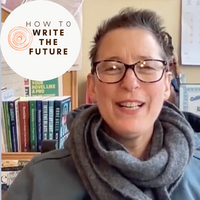 Beth Barany teaches science fiction and fantasy novelists how to write, edit, and publish their books as a coach, teacher, consultant, and developmental editor. She’s an award-winning fantasy and science fiction novelist and runs the podcast, “How To Write The Future.”
Beth Barany teaches science fiction and fantasy novelists how to write, edit, and publish their books as a coach, teacher, consultant, and developmental editor. She’s an award-winning fantasy and science fiction novelist and runs the podcast, “How To Write The Future.”
Learn more about Beth Barany at these sites:
Author site / Coaching site / School of Fiction / Writer’s Fun Zone blog
CONNECT
Contact Beth: https://writersfunzone.com/blog/podcast/#contact
Email: beth@bethbarany.com
LinkedIn: https://www.linkedin.com/in/bethbarany/
CREDITS
EDITED WITH DESCRIPT: https://www.descript.com?lmref=_w1WCA
MUSIC: Uppbeat.io
DISTRIBUTED BY BUZZSPROUT: https://www.buzzsprout.com/?referrer_id=1994465
- SHOW PRODUCTION BY Beth Barany
- SHOW NOTES by Kerry-Ann McDade
For more “How To Write the Future” episodes, go here.
If you’d like to invite Beth onto your podcast, drop her a note here.

